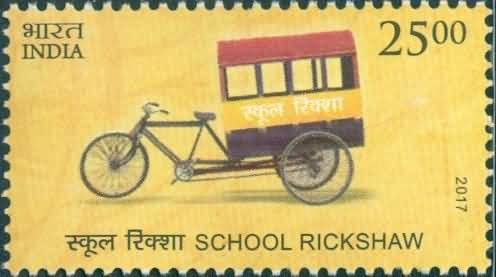School Rickshaw

Technical Data
| Stamp Set | Means of Transport |
|---|---|
| Date of Issue | March 25, 2017 |
| Denomination | Rs. 25 |
| Quantity | 3,000 |
| Perforation | 13 |
| Printer | India Security Press, Nashik |
| Printing Process | Wet Offset |
| Watermark | No Watermark |
| Colors | Multicolor |
| Credit (Designed By) | Sh. Brahm Prakash |
| Catalog Codes |
Michel IN 3138 Yvert et Tellier IN 2829 Stanley Gibbons IN 3292 |
| Themes | Transport |
Introduction
The evolution of rickshaws in India led to various adaptations, one of which is the School Rickshaw—a familiar and essential mode of transport for school-going children in many towns and cities of India. Designed for safety and convenience, it provides an economical and accessible means of daily commute for young students.
From Pulled Rickshaws to School Rickshaws
Rickshaws first appeared in India around 1880, starting as hand-pulled carts and later evolving into cycle and auto rickshaws. Over time, the need for a safe and affordable transport option for children resulted in the creation of the School Rickshaw, popularly known for carrying groups of children to and from school.
Design and Usage
A School Rickshaw is generally a pedal-driven or cycle-based rickshaw, modified with:
- A covered roof for weather protection
- Seats arranged to accommodate multiple children
- Safety railings or enclosures
It is a common sight in smaller towns, urban colonies, and areas where school buses cannot easily enter.
Role in Community Mobility
The School Rickshaw remains a trusted mode of transportation, especially in local neighbourhoods. It is:
- Affordable for families
- Eco-friendly, as it does not use fuel
- Easily accessible in narrow streets and residential areas
It supports daily education by ensuring regular school attendance for children who might otherwise lack convenient transportation.
Conclusion
More than just a vehicle, the School Rickshaw is a symbol of community-based mobility, contributing to children’s education and social development. It reflects India’s adaptive spirit—transforming traditional rickshaw models into a safe, practical, and child-friendly mode of transport.
